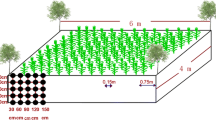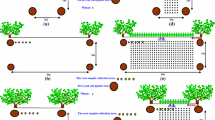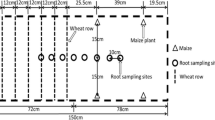Abstract
Intercropping Persian walnut (Juglans regia L.) and wheat (Triticum aestivum Linn.) in northwest China is receiving increasing attention because it offers potential advantages for improving land-use efficiency, increasing economic returns to farmers and increased sustainability in crop production. We carried out a two-year field intercropping experiment, using a system composed of young Persian walnut trees with wheat to determine the root competitive interactions between the two species, aboveground biomass and the economic yield of each component of the intercropping system at a spacing of 4 × 6 m in Hetian old oasis, south Xinjiang province, northwest China. Roots were sampled by auger in the Persian walnut tree/wheat intercropping system and in the sole wheat and sole walnut systems, down to a depth of 1 m in the soil profile. The results show that the roots of the trees spread under the crop and that the roots of intercropped wheat tended to have a shallower distribution in the soil profile. The roots of both intercropped walnut and wheat had a lower root length density and root diameter and a higher specific root length at all soil depths than those of sole walnut trees and wheat in 2012. Although root competition belowground led to decreases in yield and biomass of both crops, intercropping of Persian walnut and wheat improved the utilization of plant growth resources (LER > 1) as compared with sole crops. Tree height, diameter at breast height and mean radius of crown of intercropped trees in both intercropping years had lower values when compared with the monoculture. We conclude that interspecific interactions occurred largely as below-ground competition between the species investigated. Competition for soil resources was the primary limiting factor for wheat productivity. Further research is needed to examine the dynamic processes of species interactions in intercropping systems with trees of increasing age.







Similar content being viewed by others
References
Ares A, Brauer D (2004) Growth and nut production of black walnut in relation to site, tree type and stand conditions in south-central United States. Agrofor Syst 63:83–90
Ashton PS (2000) Ecological theory of diversity and its applications to mixed species plantation systems. In: Ashton MS, Montagnini F (eds) The silvicultural basis for agroforestry systems. CRC Press, Boca Raton, pp 61–77
Bertin C, Yang X, Weston LA (2003) The role of root exudates and allelochemicals in the rhizosphere. Plant Soil 256:67–83
Bohanek JR, Groninger JW (2005) Productivity of European black alder (Alnus glutinosa) interplanted with black walnut (Juglans nigra) in Illinois, USA. Agrofor Syst 64:99–106
Böhm W (1979) Methods of studying root systems. Springer, Berlin
Bolte A, Villanueva I (2006) Interspecific competition impacts on the morphology and distribution of fine roots in European beech (Fagus sylvatica L.) and Norway spruce (Picea abies (L.) Karst.). Eur J For Res 125:15–26
Burner DM, Brauer DK (2003) Herbage response to spacing of loblolly pine trees in a minimal management silvopasture in southeastern USA. Agrofor Syst 57:69–77
Cannell MGR, Van Noordwijk M, Ong CK (1996) The central agroforestry hypothesis: the tree must acquire resources that the crop would not otherwise acquire. Agofor Syst 34:27–31
Cao FL, Kimmins JP, Wang JR (2012) Competitive interactions in Ginkgo and crop species mixed agroforestry systems in Jiangsu, China. Agrofor Syst 84:401–415
Chamshama SAO, Mugasha AG, Kløvstad A, Haveraaen O, Maliondo SMS (1998) Growth and yield of maize alley cropped with Leucaena leucocephala and Faidherbia albida in Morogoro, Tanzan. Agrofor Syst 40:215–225
Dhima KV, Lithourgidis AS, Vasilakoglou LB, Dordsas CA (2007) Competition indices of common vetch and cereal intercrops in two seeding ratio. Field Crop Res 100:249–256
Droppelmann KJ, Ephrath JE, Berliner PR (2000) Tree/crop complementarity in an arid zone runoff agroforestry system in northern Kenya. Agrofor Syst 50:1–16
Eissenstat DM, Yanai RD (1997) The ecology of root life span. Adv Ecol Res 27:1–6
Fitter AH (1991) Characteristics and functions of root systems. In: Waisel Y, Eshel A, Kafkafi U (eds) Plant roots: the hidden half. Marcel Dekker, New York, pp 3–25
Fletcher EH III, Thetford M, Sharma J, Jose S (2012) Effect of root competition and shade on survival and growth of nine woody plant taxa within a pecan [Carya illinoinensis (Wangenh.) C. Koch] alley cropping system. Agrofor Syst 86:49–60
Gao LB, Xu HS, Bi HX, Xi WM, Bao B, Wang XY, Bi C, Chang YF (2013) Intercropping competition between apple trees and crops in agroforestry systems on the Loess Plateau of China. Plos One 8:1–8. http://www.plosone.org/article/info%3Adoi%2F10.1371%2Fjournal.pone.0070739
García-Barrios L, Ong CK (2004) Ecological interactions in simultaneous agroforestry systems in the tropics: management lessons. Agrofor Syst 61:221–236
Garrett HE, Jones JE (1998) Companion crop recommendations for planting with black walnuts. In: Jones JE, Mueller R, Van Sambeek JW (eds). Nut production handbook for eastern black walnut. Southwest Missouri Resources, Conservation & Development (RC & D) Inc. Columbia, pp 102–104
George SJ, Kumar BM, Wahid PA, Kamalam NV (1996) Root competition for phosphorus between the tree and herbaceous components of silvopastoral systems in Kerala, India. Plant Soil 179:189–196
Gillespie AR, Jose S, Mengel DB, Hoover WL, Pope PE, Seifert JR, Biehle DJ, Stall T, Benjamin TJ (2000) Defining competition vectors in a temperate alley cropping system in the midwestern USA. 1 Production physiology. Agrofor Syst 48:25–40
Grams TEE, Kozovits AR, Winkler JB, Sommerkorn M, Blaschke H, Häberle KH, Matyssek R (2002) Quantifying competitiveness in woody plants. Plant Biol 4:153–158
Greb BW, Black AL (1961) Effects of windbreak plantings on adjacent crops. J Soil Water Conserv 16:223–227
Gregory PJ (1996) Approaches to modeling the uptake of water and nutrients in agroforestry systems. Agrofor Syst 34:51–65
Gruenewalda H, Brandt BKV, Schneider BU, Bens O, Kendziab G, Hüttl RF (2007) Agroforestry systems for the production of woody biomass for energy transformation purposes. Ecol Eng 29:319–328
Hauggaard-Nielsen H, Ambus P, Jensen ES (2001) Temporal and spatial distribution of roots and competition for nitrogen in pea-barley intercrops—a field study employing 32P technique. Plant Soil 236:63–74
Hendriks CMA, Bianchi FJJA (1993) Root density and root biomass in pure and mixed forests of Douglas fir and beech. Neth J Agric Sci 43:321–331
Imo M (2009) Interactions amongst trees and crops in taungya systems of western Kenya. Agrofor Syst 76:265–273
Jama BA, Nair PKR, Rao MR (1995) Productivity of hedgerow shrubs and maize under alley cropping and block planting systems in semiarid Kenya. Agrofor Syst 31:257–274
Jamaludheen V, Kumar BM, Wahid PA, Kamalam NV (1997) Root distribution pattern of the wild jack tree (Artocarpus hirsutus Lamk.) as studied by 32P soil injection method. Agrofor Syst 35:293–336
Jose S, Gillespie AR (1998a) Allelopathy in black walnut (Juglans nigra L.) alley cropping. I. Spatio-temporal variation in soil juglone in a black walnut-corn (Zea mays L.) alley cropping system in the midwestern USA. Plant Soil 203:191–197
Jose S, Gillespie AR (1998b) Allelopathy in black walnut (Juglans nigra L.) alley cropping. II. Effects of juglone on hydroponically grown corn (Zea mays L.) and soybean (Glycine max L. Merr.) growth and physiology. Plant Soil 203:199–205
Jose S, Gillespie AR, Seifert JR (2000a) Defining competition vectors in a temperate alley cropping system in the Midwestern USA. 2. Competition for water. Agrofor Syst 48:41–49
Jose S, Gillespie AR, Seifert JR, Mengel DB, Pope PE (2000b) Defining competition vectors in a temperate alley cropping system in the mid-western USA. 3. Competition for nitrogen and litter decomposition dynamics. Agrofor Syst 48:61–77
Jose S, Gillespie AR, Seifert JR, Pope PE (2001) Comparison of minirhizotron and soil core methods for quantifying root biomass in a temperate alley cropping system. Agrofor Syst 52:161–181
Jose S, Gillespie AR, Pallardy SG (2004) Interspecific interactions in temperate agroforestry. Agrofor Syst 61:237–255
Jose S, Williams RA, Zamora DS (2006) Belowground ecological interactions in mixed-species forest plantations. For Ecol Manag 233:231–239
Li Z-X, Yang L-L, Abulizi B, Yan S-K, Liu K, Zhu Z-J, Yang Z-Q, Liu J, Sheng X-H, Maihemujiang, Ma Z-J (2014) The development of walnut mechanization of production equipment in Xinjiang. Xinjiang Agric Sci 51:973–980
Lin CH, McGraw RL, George MF, Garrett HE (1999) Shade effects on forage crops with potential in temperate agroforestry practices. Agrofor Syst 44:109–119
Livesley SJ, Gregory PJ, Buresh RJ (2000) Competition in tree-row agroforestry systems. 1. Distribution and dynamics of fine roots length and biomass. Plant Soil 227:149–161
Mead R, Willey RW (1980) The concept of a land equivalent ratio and advantages in yields from intercropping. Exp Agric 16:217–228
Nissen TM, Midmore DJ, Cabrera ML (1999) Aboveground and belowground competition between intercropped cabbage and young Eucalyptus torelliana. Agrofor Syst 46:83–93
Ong CK, Black CR, Marshall FM, Corlett JE (1996) Principles of resource capture and utilization of light and water. In: Ong CK, Huxley P (eds) Tree-crop interactions: a physiological approach. CAB International, Wallingford, pp 73–158
Ozkan MM (2009) Some nutritional characteristics of fruit and oil of walnut (Juglans regia L.) growing in Turkey. Iran J Chem Chem Eng 28:57–62
Ozkan G, Koyuncu MA (2005) Physical and chemical comparison of some walnut (Juglans regia L.) genotypes grown in Turkey. Grasas Aceites 56:141–146
Pham CH, Yen CP, Cox GS, Garrett HE (1977) Slope position, soil water storage capacity, and black walnut root development. In: Balmer WE (ed) Soil moisture-site productivity management symposium. USDA Forest Service, Southern Forest Experiment Station, Myrtle Beach, pp 326–335
Qiao X, Lei JJ, Chen XW, Zhao Q, Zhang HZ, Huang TR, Li GK (2012) Study on growth, development and yield formation of wheat under walnut-wheat intercropping system. Chin J Agrometeorol 33:540–544
Rao MR, Sharma MM, Ong CK (1990) A study of the potential of hedge row intercropping in semi-arid India using a 2-way systematic design. Agrofor Syst 11:243–258
Rao MR, Sharma MM, Ong CK (1991) A tree/crop interface design and its use for evaluating the potential of hedge row intercropping. Agrofor Syst 13:143–158
Rivest D, Cogliastro A, Bradley RL, Olivier A (2010) Intercropping hybrid poplar with soybean increases soil microbial biomass, mineral N supply and tree growth. Agrofor Syst 80:33–40
Schmid I (2002) The influence of soil type and interspecific competition on the fine root system of Norway spruce and European beech. Basic Appl Ecol 3(4):339–355
Schroth G (1999) A review of belowground interactions in agroforestry, focussing on mechanisms and management options. Agrofor Syst 43:5–34
Scott R, Sullivan WC (2007) A review of suitable companion crops for black walnut. Agrofor Syst 71:185–193
Singh RP, Ong CK, Saharan N (1989) Above and below ground interactions in alleycropping in semi-arid India. Agrofor Syst 9:259–274
Stone EL, Kalisz PJ (1991) On the maximum extent of tree roots. For Ecol Manag 46:59–102
Teklehaimanot JB, Quedraogo SJ (2004) Fine root distribution of pruned trees and associated crops in parkland system in Burkina Faso. Agrofor Syst 60:13–26
van Asten PJA, Wairegi LWI, Mukasa D, Uringi NO (2011) Agronomic and economic benefits of coffee–banana intercropping in Uganda’s smallholder farming systems. Agric Syst 104:326–334
Van Noordwijk M, Purnomosidhi MP (1995) Root architecture in relation to tree–soil–crop interactions and shoot pruning in agroforestry. Agrofor Syst 30:161–173
Vandermeer JH (1989) The ecology of intercropping. Cambridge University Press, New York
Wanvestraut RH, Jose S, Nair PKR, Brecke BJ (2004) Competition for water in a pecan (Carya illinoensis K. Koch)—cotton (Gossypium hirsutum L.) alley cropping system in the southern United States. Agrofor Syst 60:167–179
Willis RJ (2000) Juglans spp., juglone and allelopathy. Allelopath J 7:1–55
Zamora DS, Jose S, Nair PKR (2007) Morphological plasticity of cotton roots in response to interspecific competition with pecan in an alley cropping system in the southern United States. Agrofor Syst 69:107–116
Zhang BJ, Gao YH (2010) Overview of walnut culture in China. Acta Hortic (ISHS) 861:39–44
Zhang W, Ahanbieke P, Wang BJ, Xu WL, Li LH, Christie P, Li L (2013) Root distribution and interactions in jujube tree/wheat agroforestry system. Agrofor Syst 87:929–939
Acknowledgments
This work was financially supported by the Chinese Ministry of Agriculture (Project No. 201003043-01) and the National Natural Science Foundation of China (Project No. 31460335). We also thank Dr. Hans Lambers and two anonymous reviewers for their valuable suggestions and comments toward improving an early version of the manuscript.
Author information
Authors and Affiliations
Corresponding author
Rights and permissions
About this article
Cite this article
Zhang, W., Ahanbieke, P., Wang, B.J. et al. Temporal and spatial distribution of roots as affected by interspecific interactions in a young walnut/wheat alley cropping system in northwest China. Agroforest Syst 89, 327–343 (2015). https://doi.org/10.1007/s10457-014-9770-x
Received:
Accepted:
Published:
Issue Date:
DOI: https://doi.org/10.1007/s10457-014-9770-x




